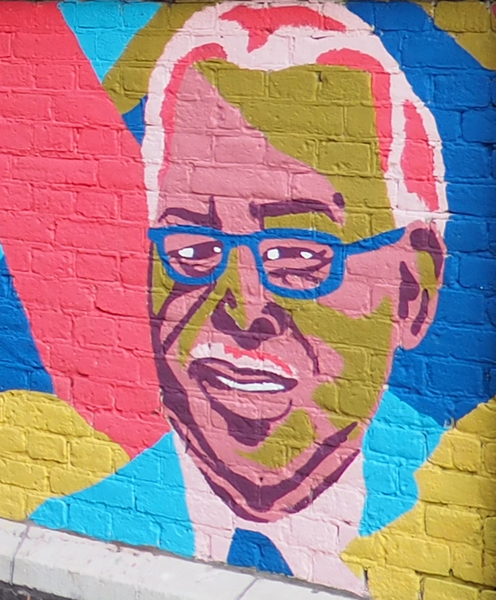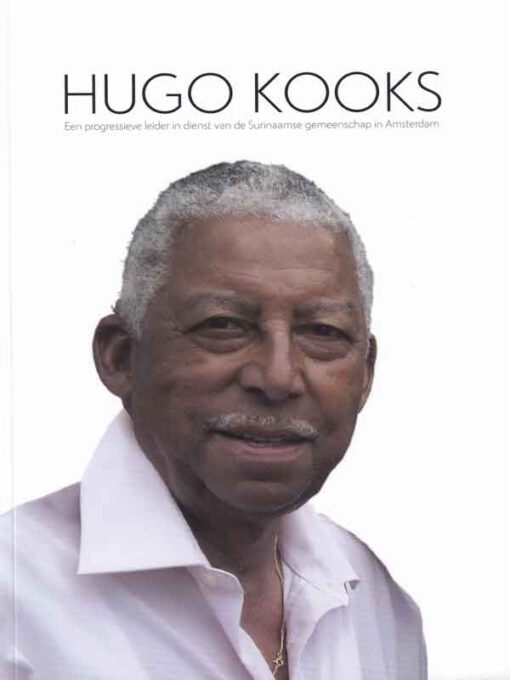A blog about (hidden) Amsterdam
A blog about (hidden) Amsterdam
“The Wall of Surinamese and Black Heroes” is a beautiful mural by Hedy Tijn & Dewy “Butterfingaz” Elsinga at the entrance to the Black Archives at the Hugo Olijfveldhuis. We want everyone to know their stories. Up next is a man who organized community from outside of the spotlight, Hugo Kooks.

Hugo Kooks spent fifty years leading Amsterdam’s Surinamese community, although I don’t think he’d put it that way. Described as a “nuanced nationalist and mild-mannered man”, he spent decades working for Suriname and the Netherlands, becoming a bridge between the two.
Hugo Kooks was born in Suriname in 1928. As a young man, he witnessed Suriname’s contribution to the Allied war effort. Surinamese men sailed Dutch supply ships and died on the Pacific front. Meanwhile, the bauxite mined in the colony was so crucial that one American general called it decisive to the Allied victory.
Imagine his surprise when he moved to the Netherlands in December of 1949. Dutch society had firmly locked the door on discussions of the war. (This may be a surprise to modern immigrants like myself, as it’s a frequent topic of conversation today.) The Surinamese community in the Netherlands was largely sidelined. And the Dutch government was determined to keep Suriname as a colony.
He very quickly became active in Wie Eegie Sanie (WES), a Surinamese students’ organization that grew into a strong advocate for Surinamese independence, and the Vereniging Ons Suriname (VOS). The VOS was founded in 1919 as cultural and social support for Surinamese people in the Netherlands. Throughout the 1950s, it became more politically oriented and merged with the WES. The Vereniging Ons Suriname became an intellectual center for Surinamese activism as well as a cultural one.
Hugo Kooks moved into a leadership role in the 1960s, which he would continue for the next five decades. While he wrote about Surinamese issues, most of his work was behind the scenes. The VOS became the center of an organizational chain reaching back to Suriname and across the Netherlands to other Surinamese groups.

Another is a photo from 1963 that shows a long parade of people in a mix of traditional Surinamese and modern dress. They carry banners marking 100 years since the legal abolition of slavery. (Black Archives icon Perez Long Joy would later point out that slavery actually ended in 1873.) Co-organized by the VOS, this is the first Keti Koti parade, a tradition that continues to this day.
Towards the end of his life, Kooks was involved in two significant additions to the historical record. Every year in the Netherlands, there are events commemorating the end of World War II. Kooks worked with the committee to set up an event honoring the Surinamese, Antillean, and Aruban sailors who worked on the dangerous Dutch supply routes. In 2007, he and VOS VP Delano Veira showed the biographers of Black Archives icon Anton de Kom previously undiscovered writing that had been stored in the VOS archives.
Hugo Kooks passed away at 82 years of age in 2011. Eight years later, the Vereniging Ons Suriname celebrated its 100-year jubilee. The celebration included a book launch for the biography of Hugo Kooks, the man who’d led the VOS for so long. Hugo Kooks left behind a community that was stronger and more connected because of him. It’s an inheritance that few are able to leave, and we are lucky to receive.
We hope you’ll join us someday on our Hidden Gems Tour, where you can learn about more incredible people like Hugo Kooks.
Check out some more Blamsterdam! posts.
Private Museum Tour
See the highlights and hidden icons of Amsterdam’s world-renowned Rijksmuseum in a private guided tour that explores who creates art and what stories it’s used to tell. And don’t worry about museum tickets. We’ve got you covered.


Small-Group Walking Tour
This historical tour through the busy Jewish quarter and residential Plantage neighborhood offers a selection of stories from BIPOC, LGBTQ+, Jewish and women’s history. It’s the perfect way to get an alternative view of Amsterdam.


Self-Guided Digital Tour
Use your phone to explore Amsterdam! This self-guided tour uses audio, images, maps, and text to introduce you to the women, BIPOC, LGBTQ+, and Jewish people who made Amsterdam what it is.


Small-Group Walking Tour
In 1593, Jewish Amsterdammers began building a community in the relative safety of the city that transformed both the Netherlands and the world. Learn about these creative, compassionate, and challenging mavericks and their impact.


Small-Group Walking Tour
The women who shaped Amsterdam are more complex than traditional tours would have you believe. Go to Amsterdam’s historic sites to hear stories of women who fought, wrote, calculated and led through the city’s chaotic and complicated past.


Small-Group Walking Tour
The world’s first gay marriage was officiated by the Mayor of Amsterdam at its City Hall. But did you know that the city’s LGBTQ+ history stretches centuries? Meet historical Amsterdammers across the gender spectrum and sexual orientations.


Private Walking Tour
Get a personalized tour that covers the interests you’re curious about and the neighborhoods you want to see. Choose pick-up/drop-off locations, any combination of our hidden history topics, and themes such as artists, politicians, and rebels.

